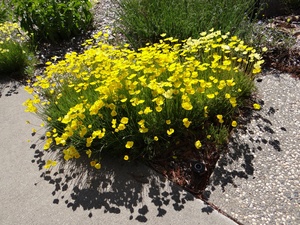 Frying Pan Poppies (Eschscholzia lobbii) in a garden in Woodland. Photo by queerbychoice.
Frying Pan Poppies (Eschscholzia lobbii) in a garden in Woodland. Photo by queerbychoice.
Poppies are flowering plants in the Poppy family (Papaveraceae), typically having deep taproots and preferring hot, dry conditions. Due to their deep taproots, they can be difficult to transplant; however, most of them are easily grown from seed.
The best known poppy species in our area is our state flower, the California Golden Poppy, which is native to Davis. But two other poppy species are also native to Davis, and three more are native to other parts of Yolo County.
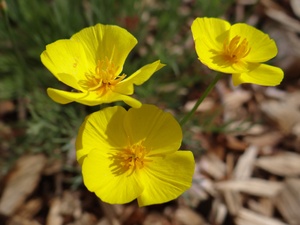 Closeup of Frying Pan Poppies (Eschscholzia lobbii) in a garden in Woodland. Photo by queerbychoice.
Closeup of Frying Pan Poppies (Eschscholzia lobbii) in a garden in Woodland. Photo by queerbychoice.
Frying Pan Poppies (Eschscholzia lobbii) are small annual herbs native to all of Davis. They grow to be about six inches tall and wide, preferring full sun and little water. They have bright yellow flowers and otherwise look much like miniature California golden poppies.
Tufted Poppies (Eschscholzia caespitosa) are small annual herbs native to the Yolo County foothills, the Capay Hills, parts of the Dunnigan Hills (including Dunnigan), and some flatlands around Esparto and Monument Hills. They grow to be about one foot tall and wide, preferring full sun and little water. They are often mistaken for California golden poppies, because they often look quite similar aside from having slightly smaller flowers. Some forms of them can have pale yellow flowers instead of orange petals. They also differ from California golden poppies in that tufted poppies are strictly annuals, whereas California golden poppies are often biennials or short-lived perennials.
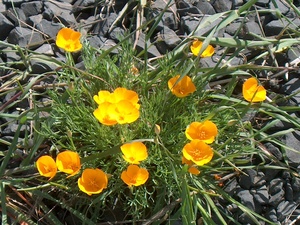 The golden form of Tufted Poppies (Eschscholzia caespitosa) closely resembles California Golden Poppies. Photo by queerbychoice.
The golden form of Tufted Poppies (Eschscholzia caespitosa) closely resembles California Golden Poppies. Photo by queerbychoice.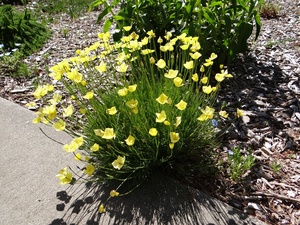 The yellow form of Tufted Poppies (Eschscholzia caespitosa), shown here in a garden in Woodland, has paler yellow flowers than Frying Pan Poppies. Photo by queerbychoice.
The yellow form of Tufted Poppies (Eschscholzia caespitosa), shown here in a garden in Woodland, has paler yellow flowers than Frying Pan Poppies. Photo by queerbychoice.
Cream Cups (Platystemon californicus) are small annual herbs native to all of Davis. They grow to be about six inches tall and wide, preferring full sun and little water. They have cream-colored petals with yellow spots on them. The placement of the yellow spots on the cream petals varies by geographic origin, being sometimes toward the center and other times toward the outside edge of the petals.
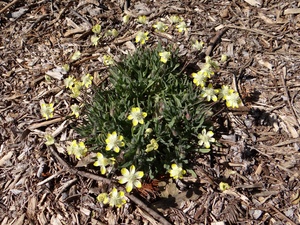 These Cream Cups (Platystemon californicus) in a garden in Woodland have the yellow spots on the outside edge of their petals, which is more typical of Southern California than of Northern California. These were likely descended from seeds collected in Southern California. Photo by queerbychoice.
These Cream Cups (Platystemon californicus) in a garden in Woodland have the yellow spots on the outside edge of their petals, which is more typical of Southern California than of Northern California. These were likely descended from seeds collected in Southern California. Photo by queerbychoice.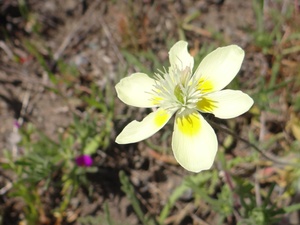 This closeup of Cream Cups (Platystemon californicus) in Bear Valley shows the typical placement of the yellow dots on the petals of Cream Cups originating in our geographic region. Photo by queerbychoice.
This closeup of Cream Cups (Platystemon californicus) in Bear Valley shows the typical placement of the yellow dots on the petals of Cream Cups originating in our geographic region. Photo by queerbychoice.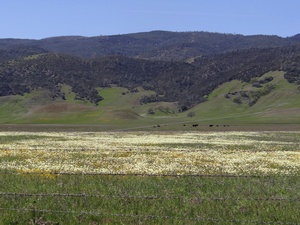 A field of Cream Cups (Platystemon californicus) and Goldfields blooming in Bear Valley. Photo by queerbychoice.
A field of Cream Cups (Platystemon californicus) and Goldfields blooming in Bear Valley. Photo by queerbychoice.
Golden Eardrops (Ehrendorferia chrysantha) are large perennial herbs native to the Yolo County foothills, including the Capay Hills. They grow to be about five feet tall, preferring full sun and little water. They have yellow flowers and are closely related to bleeding hearts.
Bush Poppies (Dendromecon rigida) are large, fast-growing shrubs native to the Yolo County foothills, including the Capay Hills. They can grow to be about ten feet tall and nearly equally wide, preferring full sun and extremely sharp drainage. They usually grow on sloped ground. They have large yellow flowers.



